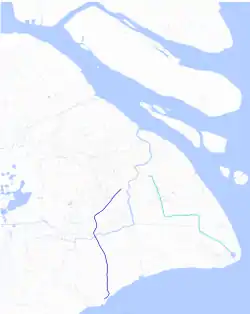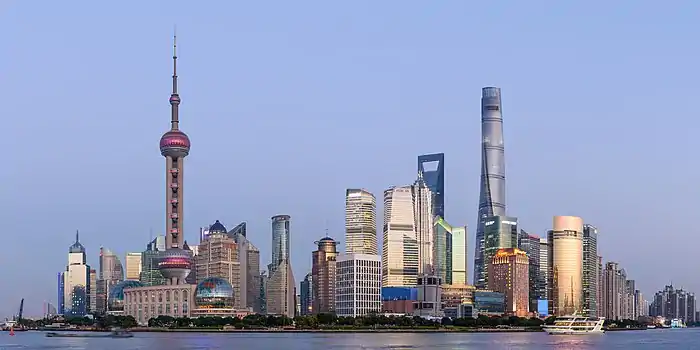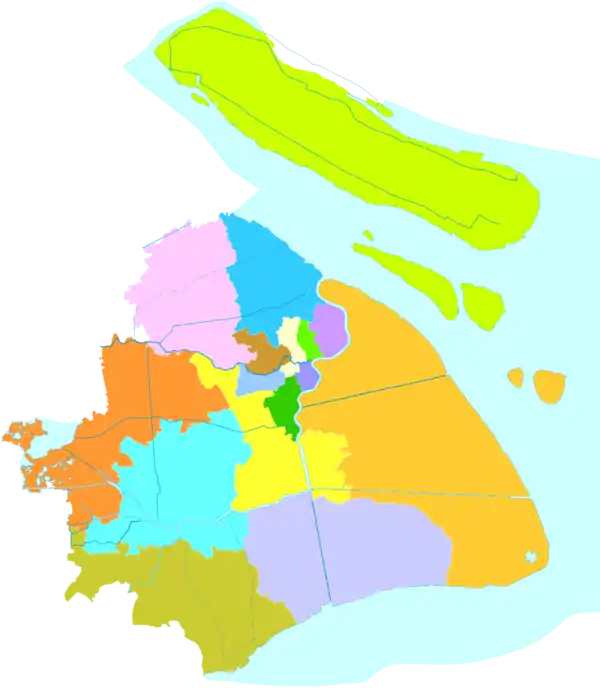Shanghai Metropolitan Area Intercity Railway
Shanghai Metropolitan Area Intercity Railway System or Shanghai Suburban Railway System is a network of regional railways radiating or surrounding the city of Shanghai, China. It is a plan for the gradual implementation of a regional rail system across the metropolitan area. The system will eventually connect with Jiangsu Yangtze MIR and Hangzhou Greater Bay Area network.
| Shanghai Metropolitan Area Intercity Railway | |||||||||||||
|---|---|---|---|---|---|---|---|---|---|---|---|---|---|
| Chinese name | |||||||||||||
| Simplified Chinese | 上海市域轨道交通 | ||||||||||||
| Traditional Chinese | 上海市域軌道交通 | ||||||||||||
| |||||||||||||
| Overview | |||||||||||||
| Locale | Shanghai | ||||||||||||
| Transit type | Commuter rail rapid transit | ||||||||||||
| Number of lines | ~13 total | ||||||||||||
| Operation | |||||||||||||
| Began operation | 28 September 2012 | ||||||||||||
| Operator(s) | China Railway/Shanghai Metro | ||||||||||||
| Technical | |||||||||||||
| Track gauge | 1,435 mm (4 ft 8+1⁄2 in) standard gauge | ||||||||||||
| Electrification | AC 25 kV overhead lines | ||||||||||||
| |||||||||||||
Overview
| Shanghai Metropolitan Area Intercity Railway | ||||||||
|---|---|---|---|---|---|---|---|---|
| Opened lines (151km, 34 stations) | ||||||||
| Line | Termini | Opened | Latest extension | Length (km) | Stations | Operator | Investment | |
| 16 | Longyang Road | Dishui Lake | 2013 | 2014 | 59 | 13 | ¥14.702 billion | |
| 17 | Hongqiao Railway Station | Oriental Land | 2017 | 35.3 | 13 | ¥17.362 billion | ||
| Jinshan 金山铁路 | Shanghai South | Jinshanwei | 2012 | 56.4 | 8 | China Railway Shanghai Group | ¥4.8 billion | |
| Under construction (196km, 38 stations) | ||||||||
| Line | Termini | Commencement | Expected opening | Length (km) | Stations | Operator | Investment | |
| Chongming 崇明线 | Jinji Road | Yu'an | March 2021 | 2027 | 42.8 | 8 | ¥19.8 billion | |
| 17 | Oriental Land | Xicen | June 2021 | 2025 | 6.6 | 1 | ¥2.9 billion (to Jinze) | |
| Airport Link 机场联络线 | Hongqiao railway station | Shanghai East railway station | June 2019 | 2024 | 68.6 | 9 | China Railway Shanghai Group | ¥48.054 billion |
| Jiamin 嘉闵线 | Yindu Road | Chengbei Road | June 2021 | 2027 | 44.04 | 14 | China Railway Shanghai Group | ¥25.6 (including north extension) |
| Lianggang Express 两港快线 | Lingang Open Area | Shanghai East railway station; Pudong International Airport T3 Terminal |
January 2022 | 2025 | 35.1 | 6 | China Railway Shanghai Group | ¥11.2 billion |
| Planned lines (short term)[1] | ||||||||
| Line | Termini | Commencement | Expected opening | Length (km) | Stations | Operator | Investment | |
| 17 | Xicen | Jinze | 6.2 | 1 | ||||
| Huping Intercity Railway 沪平城际铁路 | Jinshanwei | Haiyan | 2021 | 2025 | 50.9 | 7 | China Railway Shanghai Group | ¥11.7 billion |
| Jiamin north extension | Chengbei Road | Taicang | 2027 | 10 | 5 | China Railway Shanghai Group | ||
| Shanghai-Suzhou-Jiaxing Line 沪苏嘉线上海段 Shanghai Demonstration Area Line 上海示范区线 | Hongqiao railway station | Shuixiangketing | May 2022 | end 2027 | 57 | China Railway Shanghai Group | ¥22 billion | |
| Nanfeng line 南枫线 | Lingang New Area | Fengjing | 93 | 8 | China Railway Shanghai Group | ¥20 billion | ||
| Fengxian line 奉贤线 | South Sanlin | Fengxian | 37 | 6 | China Railway Shanghai Group | ¥15 billion | ||
Suburban railway routes
Operational lines
- Jinshan railway
- Line 16, Shanghai Metro (Operated by Shanghai Metro)
- Line 17, Shanghai Metro (Operated by Shanghai Metro)
Lines under construction
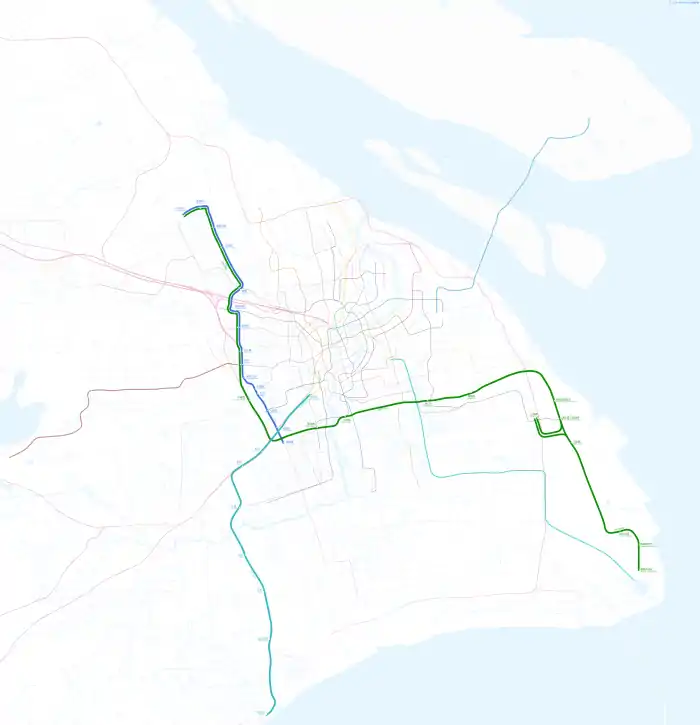
- Airport Link line (机场联络线) (construction started on June 28, 2019, opening in 2024[4])
- Chongming line (崇明线, Operated by Shanghai Metro; not operated by China Railway)[5] (Construction started on March 29, 2021, opening in 2027)
- Jiamin line (嘉闵线) (Construction started on June 28, 2021, opening in 2027[6])
- Lianggang Express line (两港快线) (construction started on January 4, 2022)
Planned lines
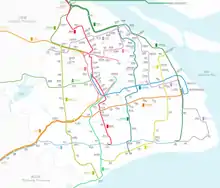
- Shanghai Demonstration Area Line (上海示范区线)
- Fengpu line (奉浦线)
- Jiaqingsongjin line (嘉青松金线)
- Chuannanfeng line (川南奉线)
- Baojia line (宝嘉线)
- Nangang line (南港线)
- East West Link line (东西联络线)
- Pudong railway (浦东铁路) (currently only freight single track non-electrified line, closed for passenger service)
On July 2, 2021, the National Development and Reform Commission issued a notice on the issuance of the "Multi-level Rail Transit Plan in the Yangtze River Delta Region".[1] The plan proposed that by 2025, the Yangtze River Delta on the track will be basically completed. The operating mileage of arterial railways is about 17,000 kilometers, of which high-speed railways are about 8,000 kilometers, forming a three-hour inter-regional traffic circle between the Yangtze River Delta and neighboring urban agglomerations and provincial capitals. The operating mileage of intercity railways is about 1,500 kilometers, and the intercity traffic circle between neighboring big cities in the Yangtze River Delta and Shanghai, Nanjing, Hangzhou, Hefei, Ningbo and surrounding cities forms a 1-1.5 hour intercity traffic circle. The operating mileage of urban (suburban) railways is about 1,000 kilometers. The Shanghai metropolitan area and the Nanjing, Hangzhou, Hefei, and Ningbo metropolitan areas form a 0.5-1 hour commuting traffic circle.
By 2035, the Yangtze River Delta will be built on high-quality modern tracks, and the Yangtze River Delta will become a network of trunk railways, inter-city railways, urban (suburban) railways, urban rail transit facilities, zero transfers in hubs, and excellent operational service quality. Rail transit is a model area for networked, integrated, intelligent, and green development of rail transit, and rail transit comprehensively leads and promotes the development of regional integration.
References
- "长江三角洲地区多层次轨道交通规划" (PDF).
- "上海市轨道交通近期建设规划(2017-2025)环境影响评价公示". 上海环境热线 (in Chinese). 18 February 2016.
- "上海市轨道交通近期建设规划(2017-2025)环境影响评价第二次公示". 上海环境热线 (in Chinese). 18 April 2016.
- "上海机场联络线共设9站 可与多条轨交和市域铁路同站换乘". 29 June 2019.
- "上海规土局:机场联络线和嘉闵线已明确采用市郊铁路制式" (in Chinese). 澎湃新闻. 10 August 2016.
- "本市17个交通建设工程集中开工 全面构建"五个新城"综合交通体系". 1 July 2021.
